News
Ten Common Myths about Freediving
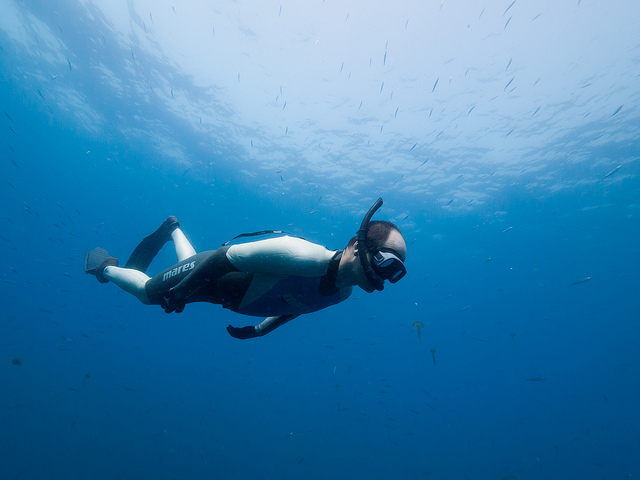
Have you ever watched the end of an underwater natural history programme on TV, and seen the ‘making of’ section? It’s where the producers give you a view of how some of the documentary was filmed. Videographers are realising that freediving is the key to capturing footage of some of the larger creatures that move between the depths and the surface. I have watched many of these tail ends, and yet I still haven’t seen one where the camera person is making the most of their freediving potential. If they did, they may be able to spend hours or days on a shoot, instead of weeks or months. An extra 30 seconds underwater can make all the difference between a brilliant sequence and nothing but blue water. The same philosophy applies to the stills photographer.
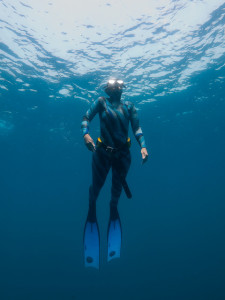 Underwater photographers typically learn their art on SCUBA equipment, and it’s a common opinion that SCUBA diving is much more advanced than freediving. As a result, not all would-be freedivers with SCUBA experience go to the trouble of taking a training course, or even reading a training manual on the subject of freediving. The argument for doing this is (at least in part) a series of common myths. I have picked out what I believe to be the top 10 of these, and taken an alternative view, based on my experiences of freediving and SCUBA.
Underwater photographers typically learn their art on SCUBA equipment, and it’s a common opinion that SCUBA diving is much more advanced than freediving. As a result, not all would-be freedivers with SCUBA experience go to the trouble of taking a training course, or even reading a training manual on the subject of freediving. The argument for doing this is (at least in part) a series of common myths. I have picked out what I believe to be the top 10 of these, and taken an alternative view, based on my experiences of freediving and SCUBA.
These myths of course, may well be shared by non-SCUBA divers and those that don’t use underwater photography equipment. Read on, and see if there are misconceptions you may have held…
1. Wearing a pair of long-bade fins means you are fully equipped for freediving
I’d be more inclined to suggest that wearing a pair of long-blade fins, if unfamiliar with using a newly purchased pair, makes you fully equipped for experiencing calf cramp! Unlike their SCUBA cousins, freediving fins come in different stiffness grades for different physiques. Buy a pair that are too stiff, and your legs won’t thank you. Of greater significance, is overlooking performance gains from using the full armoury of freediving equipment available. An open-cell freediving suit will ease your progress through the water, a ‘Marseilles’ weight belt will allow you to breathe more deeply, and the correct snorkel type will minimise drag. Some items only add minor benefits, but when combined, the sum of the various parts can make a substantial difference.
2. There’s no need for anyone else in the water to keep an eye on you
Anyone who holds their breath underwater introduces the risk of shallow water blackout. Anyone who experiences shallow water blackout on their own dies. There are very, very few exceptions to this. This is reason enough to freedive in pairs, but there are numerous other benefits that another pair of eyes and hands bring. The old counterargument here is, “I don’t hold my breath long enough or dive deep enough to experience black out”. Similarly, the Russian roulette player could argue, “I don’t put enough bullets in my pistol for it to fire each time”.
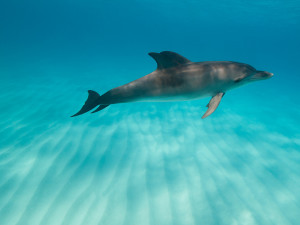 3. You won’t have time to stretch or prepare your breathing before getting in the water
3. You won’t have time to stretch or prepare your breathing before getting in the water
I never have time to update my status on Facebook, yet I do seem to make time to eat my breakfast in the mornings. We make time to do the things that need priority. We all know the benefits of stretching muscles before use, and reducing the likelihood of injury. But did you know that certain stretches can help with equalisation? Or that breath hold pre-conditioning delivers benefits for up to 10 minutes or so? If you are bouncing around in a RIB on the way to somewhere and you need to get into the action quickly, I appreciate there’s a challenge…but equally there is always a compromise, to whatever degree.
4. It’s more important than anything else to find a way of holding your breath for longer
Attend a freediving competition, and you may change your mind on this. Most pool-based competitions (did you know that the majority of freediving competitions are held in swimming pools?) have a ‘static’ breath hold discipline. You just hold your breath for as long as possible. The ‘dynamic’ discipline means swimming as far as you can in distance. You would expect the athletes with the longest breath hold times to be the longest distance swimmers. Occasionally that happens, but most times not. The best dynamic athletes just have the most efficient style and performance. And here’s the rub – breath hold ability takes time and gradual improvement. One aspect of bad style can often be corrected in an hour’s training session, and bring about significant improvement. From what I see of our wildlife photographers on television, there’s plenty of technique improvement possible for the vast majority.
5. Hyperventilating seems to be helpful
To send you to a watery grave, yes. Remember that shallow water blackout I referred to earlier? Hyperventilating makes that process a whole lot easier. It’s all about ‘blowing’ carbon dioxide out of the blood stream, and relaxing the urgency to want to breathe. At the same time, a number of other physiological processes happen, which reduce the amount of oxygen reaching the brain. So add the two effects together, and the lights can go out while you may think you are well within your comfort zone.
6. Surface floatation devices have no practical use for the freediver
Unless of course you want something to attach a dive flag to, deposit your snorkel inside (if the float has an inside), rest on after your dive, attach a weighted line to so that you dive downward in a straight line, or simply increase your visibility to your boat cover.
7. Using a weight belt is unnecessary and slows you down
Perhaps I’m cheating here – I must admit I haven’t actually heard anyone saying this, unlike most of the other myths. But from what I see, most inexperienced freedivers either don’t wear a belt, or more commonly don’t attach enough lead. They then use most of their energy fighting buoyancy throughout the dive. It’s probably another overspill from SCUBA diving, where experienced SCUBA divers wear as little lead as possible. I certainly don’t advocate overweighting, but the more neutral you attain your buoyancy, the more efficient your forward motion. Of course, adding lead isn’t the only solution – a little more depth will reduce buoyancy, as will a little less air in the lungs (with the emphasis on ‘little’). But you should be wearing a wetsuit, and therefore some ballast will be necessary. Body builders who refuse to wear wetsuits – you win the argument in this instance.
8. Freediving means getting closer to marine life and making physical contact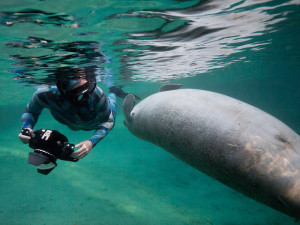
I think it’s fair to say that most of us overstep the mark here now and again, and get closer to wildlife than we should. The wildlife documentaries don’t set a good example, especially the sensationalist ones where we see the presenter wrestling with a large reptile. Just getting into the water and entering a wild animal’s territory is having some form of impact, so none of us are squeaky clean. I try to adopt the principle of the 3 R’s – Research, Regulations, and Respect. There’s no excuse for not finding out about the animal you are studying or filming, and I believe (or hope) that most of us do at least some research beforehand. But what are the legal regulations and recommendations about your presence? These should be observed too, as they are there for good reason. Beyond these two principles is the straightforward respect and commonsense we should apply. One particular type of image I am seeing now and again, is that of an oceanic shark with a freediver dangling from its dorsal fin. Has the shark given out a secret signal to say they would quite like to do this? Is there a hidden benefit to that particular shark, or the species as a whole from this activity? Or is it just ego and bravado on the part of two humans, encouraging others to do likewise until the inevitable accident occurs, and a retaliatory cull then ensues? Before you interact with wild creatures, ask yourself a few questions, and make sure you have good answers. Not to avoid fines or jail sentences, but in the interests of protection and conservation.
9. You have the flexibility to SCUBA dive in the morning followed by freediving in the afternoon
SCUBA diving causes nitrogen to dissolve into the blood and tissues, and takes some hours after the dive to be completely eliminated. You SCUBA people know this; it’s why you don’t fly until your dive computer clears. However, you can quite happily dive again an hour or so after your first SCUBA dive. This is because the dive tables and computer algorithms take into account your previous compression, and apply a penalty. There are no freediving tables (at least not yet), so the act of recompressing by freediving is not possible to assess. But it is certain that you won’t be doing a 3 minute safety stop at 5 metres on your freedive, and that you won’t be making a slow ascent either! If you have been on a liveaboard in the past, mixed SCUBA and freediving, and avoided decompression sickness…count yourself lucky.
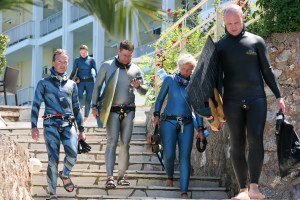 10. You won’t need a training course to teach you advanced snorkelling
10. You won’t need a training course to teach you advanced snorkelling
If nothing you have read so far has been unknown to you, even then I would recommend being properly trained in freediving. You have the opportunity to gain recognised certification, have your technique analysed and corrected, gain full understanding of safety aspects and issues (I have only scratched the surface here), and meet other like-minded people. You might even have fun as well.
Blogs
The Ocean Cleanup Breaks 10,000,000 KG Barrier

The Ocean Cleanup, the global non-profit project, has removed a verified all-time total of ten million kilograms (22 million lbs.) of trash from oceans and rivers around the world – approximately the same weight as the Eiffel Tower.
To complete its mission of ridding the oceans of plastic, The Ocean Cleanup uses a dual strategy: cleaning up the Great Pacific Garbage Patch (GPGP) to remove the plastic already afloat in the oceans, while stopping the flow of plastic from the world’s most polluting rivers.
Through cleaning operations in the GPGP and in rivers in eight countries, the cumulative total of trash removed has now surpassed ten million kilograms. This milestone demonstrates the acceleration of The Ocean Cleanup’s impact, while underlining the astonishing scale of the plastic pollution problem and the need for continued support and action.
While encouraging for the mission, this milestone is only a staging point: millions more tons of plastic still pollute our oceans and The Ocean Cleanup intends to continue learning, improving and innovating to solve this global catastrophe.
This announcement comes as governments from around the world meet to continue negotiations to develop a new legally binding instrument to end plastic pollution at INC4 in Ottawa, Canada. Representatives of The Ocean Cleanup will be in attendance and the organization will be urging decision-makers to collaborate towards a comprehensive and ambitious global treaty which addresses plastic at all stages of its life cycle and in all marine environments worldwide, including in areas beyond national jurisdiction.
It is encouraging to see that the need for remediation is reflected in the various options for potential treaty provisions. It is essential that the final treaty contains clear targets for the remediation of legacy plastic pollution, and reduction of riverine plastic emissions.
Tackling plastic pollution requires innovative and impactful solutions. The treaty should therefore incentivize the innovation ecosystem by fostering innovations that make maximal use of data, technology and scientific knowledge – such as those designed and deployed by The Ocean Cleanup.
‘After many tough years of trial and error, it’s amazing to see our work is starting to pay off – and I am proud of the team who has brought us to this point.’ said Boyan Slat, Founder and CEO of The Ocean Cleanup. ‘While we still have a long way to go, our recent successes fill us with renewed confidence that the oceans can be cleaned.’
The Ocean Cleanup was founded in 2013 and captured its first plastic in 2019, with the first confirmed catch in the GPGP coming soon after the deployment of Interceptor 001 in Jakarta, Indonesia. After surpassing one million kilograms of trash removed in early 2022, the non-profit project has since progressed to the third iteration of its GPGP cleaning solution, known as System 03, and a network of Interceptors currently covering rivers in eight countries, with more deployments set for 2024.
About The Ocean Cleanup
The Ocean Cleanup is an international non-profit organization that develops and scales technologies to rid the world’s oceans of plastic. They aim to achieve this goal through a dual strategy: stemming the inflow via rivers and cleaning up the legacy plastic that has already accumulated in the ocean. For the latter, The Ocean Cleanup develops large-scale systems to efficiently concentrate the plastic for periodic removal. This plastic is tracked and traced through DNV’s chain of custody model to certify claims of origin when recycling it into new products. To curb the tide via rivers, The Ocean Cleanup has developed Interceptor™ solutions to halt and extract riverine plastic before it reaches the ocean. Founded in 2013 by Boyan Slat, The Ocean Cleanup now employs a broadly multi-disciplined team of approximately 140. The foundation is headquartered in Rotterdam, the Netherlands.
For more information, visit: theoceancleanup.com and follow @theoceancleanup on social media.
Marine Life & Conservation
Steve Backshall to headline Shark Trust’s flagship event: For the Love of Sharks

Join a host of amazing, shark loving, speakers including Steve Backshall and the Shark Trust team for an evening celebrating shark conservation at the Royal Geographical Society in London this November.
Date: 29th November 2024
Time: 6-10pm
Location: Royal Geographical Society, London
Tickets: https://www.sharktrust.org/Event/flos24
The event will be a celebration of all things shark. Those lucky enough to get hold of tickets will hear from engaging guest speakers with a passion for sharks.
The line-up includes (*subject to change if unforeseen circumstances arise)
Steve Backshall: One of television’s busiest presenters, BAFTA award-winning wildlife expert Steve has been passionate about the wild world ever since he was young.
Steve’s impressive TV career has taken him all around the world, investigating a wide array of species and environments. Steve has filmed over 100 hours of children’s wildlife programmes with the BAFTA award winning Deadly 60 franchise and recently, with Sky Nature, for his new series ‘Whale with Steve Backshall’. He has been a patron for the Shark Trust for 10 years.
Simon Rogerson: is a photojournalist specialising in natural history, diving and the sea.
He is editor of SCUBA magazine, the official journal of the British Sub-Aqua Club. Simon started his career as a crime reporter but gravitated towards his ‘less depressing’ interest in underwater exploration, joining the staff of DIVE magazine in 1999. In 2005 he was named ‘Editor of the Year’ in the PPA’s Independent Publishing Awards. Simon also works as a freelance writer, contributing frequently to the Sunday Times and Telegraph, in addition to BBC Wildlife, Esquire, and a host of international diving magazines. He is the author of a book, Dive Red Sea, published by Ultimate Sports. Now based in Berkshire, Simon has been a Patron of the Shark Trust for 20 years.
More speakers to be announced soon. Head to the Shark Trust website to learn more.
The evening will also allow guests the final chance to see the Oceanic 31, shark art exhibition. Some of the artwork will be auctioned/raffled at the event, while the rest will be auctioned online to raise money for the Shark Trust Oceanic Programme.
For the Love of Sharks is an evening with something for everyone who is interested and fascinated by sharks. Join the Shark Trust, their Patrons, Trustees and Staff, along with a host of supporters for this celebration of shark conservation.
For more information or to buy a ticket: https://www.sharktrust.org/Event/flos24
-

 News3 months ago
News3 months agoHone your underwater photography skills with Alphamarine Photography at Red Sea Diving Safari in March
-

 News3 months ago
News3 months agoCapturing Critters in Lembeh Underwater Photography Workshop 2024: Event Roundup
-

 Marine Life & Conservation Blogs3 months ago
Marine Life & Conservation Blogs3 months agoCreature Feature: Swell Sharks
-

 Blogs2 months ago
Blogs2 months agoMurex Resorts: Passport to Paradise!
-

 Blogs2 months ago
Blogs2 months agoDiver Discovering Whale Skeletons Beneath Ice Judged World’s Best Underwater Photograph
-

 Gear Reviews3 weeks ago
Gear Reviews3 weeks agoGEAR REVIEW – Revolutionising Diving Comfort: The Sharkskin T2 Chillproof Suit
-

 Gear Reviews3 months ago
Gear Reviews3 months agoGear Review: Oceanic+ Dive Housing for iPhone
-

 Marine Life & Conservation2 months ago
Marine Life & Conservation2 months agoSave the Manatee Club launches brand new webcams at Silver Springs State Park, Florida





